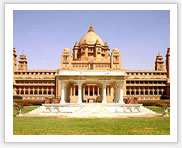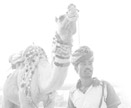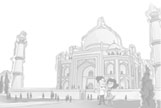
Jodhpur, once the capital of the former princely state of Marwar, is now the second largest city of Rajasthan. Flanked on its western side by the Mehrangarh Fort, and on the eastern side by the stately sandstone Palace of Umaid Bhawan; the monuments temples and gardens of Jodhpur depict a multi-faceted grandeur. Founded in 1459 AD by the Suryavanshi Rao Jodha, Jodhpur gradually grew around the towering Mehrangarh Fort, built as a stronghold on the advice of a sage.
Rajasthan City Guide
JODHPUR CITY TOUR
Jodhpur, once the capital of the former princely state of Marwar, is now the second largest city of Rajasthan. Flanked on its western side by the Mehrangarh Fort, and on the eastern side by the stately sandstone Palace of Umaid Bhawan; the monuments temples and gardens of Jodhpur depict a multi-faceted grandeur. Founded in 1459 AD by the Suryavanshi Rao Jodha, Jodhpur gradually grew around the towering Mehrangarh Fort, built as a stronghold on the advice of a sage. Alongwith Bikaner and Jaisalmer, Jodhpur too is situated on the ancient silk route that linked Central Asia and Northern India with the seaports of Gujarat.

As a result it became a major trading centre in the 16th century. Reminiscent of the bygone years is the fact that Jodhpur is still the leading centre for cattle, camels, wood, salt and agricultural crops. The beauty and imagination that has gone into the making of this monumental city proclaim the life-springs of creative genius that appear incongurent with the harshness of this land and its climate. Mehrangarh Fort- In the turbulent political times of 1459 AD. Rao Jodha was adviced by a saint to establish an impregnable head-quarter and so, the Mehrangarh Fort was built on a steep hill.
In 1459 AD, Rao Jodha, chief of Rathore clan of Rajputs, who claimed descent from Rama, the epic here of the Ramayana, laid the foundation of Jodhpur. A high stone wall protects the well-fortified city. The wall is nearly 10km in length and has eight gates facing various directions.
Within, stands an imposing fort on a low range of sandstone hills, about 125m above the surrounding plains. Invincible! And dauntless in its league with time! The city lies at the foot of the hills. The clear distinction between the old and the new city is visible from the ramparts of the fort.
On the other side of the city, facing the fort is the Umaid Bhawan Palace. One of the most spacious, sprawling and well-planned palaces in India. And from here, as you look at fort, a tantalizing view rises before your eyes at sunset.
The peculiar slant of the sunset lends the desert landscape an awe-inspiring glow and the people, a chivalry undaunted.
 Tourist Attractions in Jodhpur
Mehrangarh Fort, Jodhpur
Tourist Attractions in Jodhpur
Mehrangarh Fort, Jodhpur
The unconquerable Rao Jodha built this impenetrable fort, which is certainly one of the best in India, on a vertical hill with a breathtaking view of the surroundings. The fort has elaborate latticed windows, intricately carved panels and gracefully curved porches.
Jaswant Thada, Jodhpur
The white marble marvel, this 19th century cenotaph was built close to the fort complex, in memorial of Maharaja Jaswant Singh II. Exceptional portraits of Jodhpur's precedent rulers are also exhibited here. Particularly captivating are the intricate latticework and the elaborate carving on the doors. The garden and water tank in front of the cenotaph are superb and heighten the tranquillity of the monument.
Umaid Bhawan Palace
This flamboyant palace was built in the 20th century as a famine relief project, with a purpose to give employment to the people for a long period of 16 years. A remarkable art-deco construction, Umaid Bhawan is resplendently maintained and one of the most impressive sights in Jodhpur. The museum within is a genuine treasure showcase of mementos displaying the royal history of Jodhpur from clocks and tea sets to paintings and royal costumes. The palace has now been converted into a heritage hotel, though it is still a royal residence in part. The museum is open to visitors for a chosen entry fee and is closed on Mondays.
Built by Maharaja Umaid Singh (1929 -1942) and named after him, this exquisite palace is also known as Chittar Palace because of the local chittar sandstone used.

It is a splendid example, of Indo-colonial and art deco style of the 30s.
A unique feature of this palace is the fact that the hand chiseled sandstone blocks have been put together in a special system of interlocking, there is not mortar binding.
A portion of the palace has been converted into a hotel, the other remains on view to visitors in form of excellent museum which houses model airplanes, weapons, antique clocks and bob watches, priceless crockery, and hunting trophies. Both sections retain the ambience of royal splendor .
Timings: 0900 to 1700 hrs.
Government Museum
Nestling in the middle of the Umaid Public Garden, this museum houses a rich collection of exhibits - armoury, textiles, local arts and crafts, miniature paintings. Portraits of rulers, manuscripts and images of Jain Tirthankars. Umaid Public Garden houses a zoo also. Timing : 1000 to 1630 hrs (Friday closed).
Girdikot & Sardarkot Market
Throbbing with activity, the colourful bazaar, near Clock tower, has narrow lanes dotted with tiny shops selling exquisite Rajashani textiles, handicrafts, clay figurines of camels and elephants, marble curios with inlay work and exquisite Rajasthani silver jewelry.
Maha Mandir Temple
Leterally, the great temple, a place where sacred glory reigns in a peaceful tranquility. Situated on Mandore road, the temple is an architectural splendor, supported by 84 pillars and ornamented with detailed designs and figures depicting various postures of Yoga. The entire structure is marked by a unique and original style.







